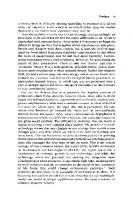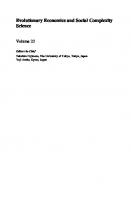Long-run Economics: An Evolutionary Approach to Economic Growth 9781472553782, 9781472514462
A major problem of conventional economic theory as applied to long-run economic change is its unduly narrow and static c
215 102 20MB
Pages [213] Year 2013
Recommend Papers

- Author / Uploaded
- Norman Clark
- Calestous Juma
File loading please wait...
Citation preview
Chapter 3 Evolutionary Approaches in Conventional Economics
This chapter undertakes a critical review of the development of evolutionary notions in traditional economics. It will show that the history of economic thought has been marked by persistent efforts to graft evolutionary notions on to traditional views. However, the efforts to break away from the traditional world-view have been unsuccessful. This tendency is clear in Adam Smith, Marx and Marshall and is also manifested in the emerging neo-Schumpeterian school.
3.1
Classical Antecedents: From Smith to Marshall
Evolutionary views of socioeconomic development in general, and technological change in particular, are not a recent academic enterprise. Their antecedents are to be seen in the work of the classical economists. For example, Darwin's work was inspired by reading Malthus's Essay on human population, and according to Schumpeter, 'the terms static and dynamic were ... introduced into economics by John Stuart Mill. Mill probably heard them from Comte, who, in turn tells us that he borrowed them from the zoologist de Brainville'. 1 Darwin's Origin of the Species consolidated a long tradition of evolutionary thought. But the application of Darwin's theory to economic development was impeded by three main factors. First, the limited knowledge on evolution and human behaviour opened the way to arguments by analogy; such arguments are often fallacious. Second, social change was not obviously gradualist, and therefore the theory was not particularly consistent with the observations of social historians (especially of the Marxists). Third, the rules of the hard sciences (especially Newtonian physics) combined with the Cartesian philosophy of nature as automata and the Baconian appeal to empirical rigour, had become the legitimate view of reality. And economics readily adopted this mechanistic world-view. Classical economists did not know as much as we do today about evolutionary concepts. 2 However, they recognized the dichotomy of static and dynamic systems. But this recognition was influenced more by mechanical dynamics than by organic evolution. It is in this context that the dynamics of Mill and Smith can be understood. Much of Smith's use of the terms 'equilibrium', 'laws of motion' and 'scientific objectivity' are drawn from Newtonian physics. The economic sphere was a
Chapter 9
In the Long Run: Institutions and Systems
In the previous chapters on fuel ethanol and photovoltaics technology, we have tried to show how technologies articulate themselves within the economic system. The overall process is characterized as one of complex evolutionary interrelationships, taking place over long time periods, strongly influenced by events within the science/technology system and involving complicated informational networks which operate in an interactive fashion to a considerable degree independent of economic markets. It is our view that such a complex social process cannot be realistically modelled by the tools of conventional economic theory that essentially apply only to specific aspects of short-run events. Indeed, the growing complexity of socioeconomics systems is such that they cannot usefully be modelled by any one social science discipline such as economics, but should instead be seen in an interdisciplinary light. We see our argument in this book as a contribution to this. It remains for us in this final chapter to do two things. In the first section we show how our approach is consistent with some of the existing modern empirical literature on innovation. The analysis will be based on microevolutionary processes and will illustrate the emergence of complexity and hierarchy in the process of technological change. It will be shown that the design of a technological system is purposive and guided by a wide range of technical, economic, social and political interrelationships, which in turn influence its morphology. The emergence of technological systems is thus closely associated with the non-linear reorganization of the economic environment. The resulting changes are both unpredictable and irreversible. The second section then concentrates upon the implications of our approach for policy-making and institutional development. In a static neoclassical world not only are 'institutions' frowned upon (they prevent the unhampered working of 'market forces'), policy-making itself is seen in terms of bringing the whole system back to a prespecified equilibrium - in terms of 'adjustment' rather than 'adaptation'. Conversely, in a complex world where the environment is constantly changing (the real world, we should argue) it is clear that policy itself must take on an evolutionary character, to be seen as the purposive generation, selection, retention and evaluation of evolutionary options under conditions of uncertainty. It is also important to recognize that technological innovation is a social process so that micro-evolutionary changes must be linked to
Bibliography
-
-
Abernathy, J. et al. (1983), Industrial Renaissance. Producing a Competitive Future for America, New York, Basic Books. and Clark, K. (1985), 'Innovation: Mapping the Winds of Creative Destruction', Research Policy, 1 4 (1): 3-22. and Utterback, J. (1978), 'Patterns of Industrial Innovation', Technology Review, 8 0 : 40-7. Abramovitz, M. (1962), 'Economic Growth in the United States', American Economic Review, 5 2 : 762-82. Aitken, H.G.F. (1984), The Continuous Wave, Princeton, Princeton University Press. Alchian, A. (1950), 'Uncertainty, Evolution and Economic Theory', Journal of Political Economy, 5 8 : 2 1 1-2 1. Allen, G.C. (1981), 'Industrial Policy and Innovation in Japan', in C. Carter (ed.), Industrial Policy and Innovation, London, Heinemann, pp. 68-87. Allen, P.M. (1985), 'Towards a New Science of Complex Systems' in United Nations University, The Science and Praxis of Complexity, Tokyo, pp. 268-97. (1985), 'Ecology, Thermodynamics and Self-organization: Towards a New Understanding of Complexity', in R. Ulanowicz and T. Platt (eds) 'Ecosystems Theory for Biological Oceanography', Special Issue of Canadian Bulletin of Fisheries and Aquatic Sciences, 2 1 3 : 3-26. (1986), 'Evolution, Innovation and Economics', paper presented at the IFIA Workshop o n Technical Change and Economic Theory (Lewes, Sussex, 18-20 October), mimeo, SPRU. Clark, N. and Perez Trejo, F.L. (1992), 'Strategic Planning of Complex Economic Systems', Review of Political Economy 4 (2), July. Altshuler, A. (1984), The Future of the Automobile, Cambridge, Mass., MIT Press. Ashworth-Gordon, F. (1980), 'Agricultural Commodity Control under Vargas in Brazil, 1930- 1945', Journal of Latin American Studies, 1 2 : 87- 105. Atkinson, A. and Stiglitz, J. (1969), 'A New View of Technological Change', Economic Journal, 79: 573-78. Ayres, C. (1944), The Theory of Economic Progress: A Study of the Fundamentals of Economic Development and Cultural Change, Chapel Hill, North Carolina University Press. Backus, C. (ed.) (1976), Solar Cells, New York, Institute of Electrical and Electronics Engineers. Barnes, B. (1977), Interests and the Growth of Knowledge, London, Routledge & Kegan Paul. (1982), T.S. Kuhn and Social Science, London, Routledge & Kegan Paul. (1983), 'On the Conventional Character of Knowledge and Cognition', in K.D. Knorr-Cetina and M. Mulkay (eds), Science Observed, London, Sage, pp. 19-51. Bates, R.H. (1989), Beyond the Miracle of the Market, New York, Cambridge University Press. Beloff, J. (1972), 'The Place of Theory in Parapsychology', in R. van Over (ed.), Psychology and Extrasensory Perception, New York, Mentor. Belussi, F. (1987), 'Benetton: Information Technology in Production and Distribution. A Case Study of the Innovative Potential of Traditional Sectors',

![Nonlinearities in Economics: An Interdisciplinary Approach to Economic Dynamics, Growth and Cycles [1 ed.]
3030709817, 9783030709815](https://ebin.pub/img/200x200/nonlinearities-in-economics-an-interdisciplinary-approach-to-economic-dynamics-growth-and-cycles-1nbsped-3030709817-9783030709815.jpg)
![Resource Economics: An Economic Approach to Natural Resource and Environmental Policy: An Economic Approach to Natural Resource and Environmental Policy, Fourth Edition [4th Revised]
1784717924, 9781784717926](https://ebin.pub/img/200x200/resource-economics-an-economic-approach-to-natural-resource-and-environmental-policy-an-economic-approach-to-natural-resource-and-environmental-policy-fourth-edition-4th-revised-1784717924-9781784717926.jpg)




![Economic Growth: A Unified Approach [2 ed.]
110711523X, 9781107115231](https://ebin.pub/img/200x200/economic-growth-a-unified-approach-2nbsped-110711523x-9781107115231.jpg)
![Economic Growth: A Unified Approach [2 ed.]
1107535603, 9781107535602](https://ebin.pub/img/200x200/economic-growth-a-unified-approach-2nbsped-1107535603-9781107535602.jpg)
